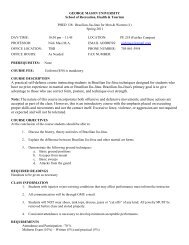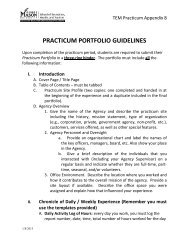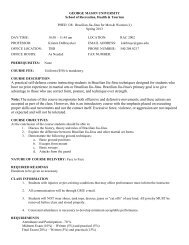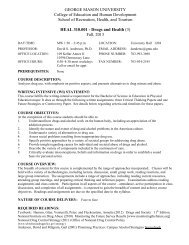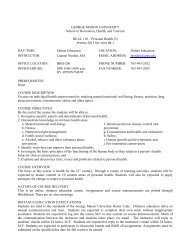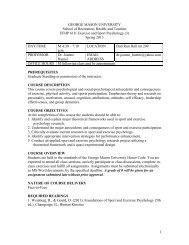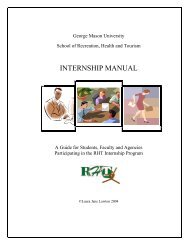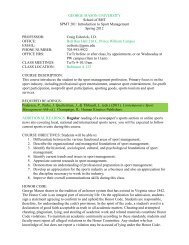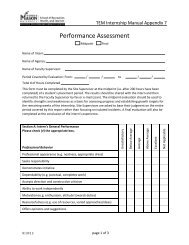Syllabus - School of Recreation, Health, and Tourism - George ...
Syllabus - School of Recreation, Health, and Tourism - George ...
Syllabus - School of Recreation, Health, and Tourism - George ...
You also want an ePaper? Increase the reach of your titles
YUMPU automatically turns print PDFs into web optimized ePapers that Google loves.
GEORGE MASON UNIVERSITY<br />
<strong>School</strong> <strong>of</strong> <strong>Recreation</strong>, <strong>Health</strong>, <strong>and</strong> <strong>Tourism</strong><br />
PRLS 173/5P1– Core Coastal Kayaking Skills 74215 (2) Credits<br />
Spring 2013<br />
DAY/TIME: 3:00 pm-5:35 pm, Fri<br />
4/05/2012<br />
4/13/2012 ,4/14/<br />
LOCATION: Pool GMU<br />
Potomac River sections<br />
4/ 20/ 21/ 2012<br />
8:30 am-5:30 pm S/S<br />
INSTRUCTOR: Mike Aron<strong>of</strong>f, ACA IT EMAIL<br />
ADDRESS:<br />
mikearon<strong>of</strong>f@aol.com<br />
www.CKAPCO.com<br />
OFFICE CKAPCO<br />
PHONE 703-264-8911<br />
LOCATION:<br />
NUMBER:<br />
OFFICE HOURS: By Appointment FAX NUMBER: 703- 716-8560<br />
COURSE FEE: $180 paid to CKAPCO prior to the class start by check or credit card for sea kayak, paddle,<br />
pfd, safety rescue gear, trailering <strong>and</strong> wet suit rental etc.<br />
PREEQUISITES: None<br />
COURSE DESCRIPTION:<br />
This course is designed to provide students with the core skills <strong>and</strong> knowledge necessary to safely paddle<br />
sea/coastal kayaks <strong>and</strong> execute trips on non whitewater rivers <strong>and</strong> coastal environments. This course will<br />
include instruction in, but not limited to, boat h<strong>and</strong>ling, terminology, kayak design, trip planning, marine<br />
hazards <strong>and</strong> safety, rules <strong>of</strong> the Nautical Road, weather <strong>and</strong> tides <strong>and</strong> environmental ethics. There will be<br />
several trips within 50 miles <strong>of</strong> GMU.<br />
OBJECTIVES:<br />
At the completion <strong>of</strong> this course students should be able to:<br />
1. Properly fit & adjust their kayak for effective control <strong>and</strong> comfort.<br />
2. Safely portage their kayak to the water.<br />
3. Attach/detach their sprayskirt.<br />
4. Properly & safely enter <strong>and</strong> exit their kayak from shore.<br />
5. Safely & effectively wet-exit their kayak.<br />
6. Demonstrate proper use & control <strong>of</strong> the paddle.<br />
7. Perform basic strokes <strong>and</strong> maneuvers. (Stroke list attached).<br />
8. Perform a T assisted - <strong>and</strong> Paddle Float Self-Rescue.<br />
9. Explain <strong>and</strong> demonstrate use <strong>of</strong> essential safety equipment.<br />
10. Describe the influence <strong>of</strong> weather <strong>and</strong> tides on the coastal kayaker.<br />
11. Identify marine hazards & safety concerns <strong>and</strong> explain strategies for dealing with them.<br />
12. Demonstrate Rules <strong>of</strong> the Nautical Road.<br />
13. State their personal limitations <strong>and</strong> skill level<br />
TEXT:<br />
Wyatt, J. Michael , Kayaking : Basic Essentials SEA KAYAKING a Falcon Guide<br />
ADDITIONAL REFERENCES:<br />
Sea Kayakers H<strong>and</strong>book by Shelly Johnson, Essentials <strong>of</strong> Kayak Touring by American Canoe Assoc.<br />
NATURE OF COURSE DELIVERY: Face to Face
EVALUATION:<br />
Skill Competencies (40%): will be required <strong>and</strong> evaluated each class session.<br />
Written Exam (20%): Written exam on coastal safety topics.<br />
Final Exam (40%): Practical evaluation on paddle strokes <strong>and</strong> maneuvers in moving water.<br />
Students will be evaluated on the following skills:<br />
1. Properly adjust foot braces <strong>and</strong> attach spray skirt<br />
2. Safely enter & exit their kayak from shore<br />
3. Perform a wet-exit with comfort & control<br />
4. Maintain good posture <strong>and</strong> balance in the kayak<br />
5. Perform the basic strokes, maneuvers & rescues with efficiency<br />
6. Identify common coastal/marine hazards<br />
7. State their physical abilities & limitations<br />
8. Explain when it is safe & appropriate to paddle<br />
GRADING<br />
A = 100-90<br />
B = 89-80<br />
C = 79-70<br />
D = 69-60<br />
F = 59 <strong>and</strong> below<br />
REQUIREMENTS:<br />
Physical exertion on this course is considered moderate to strenuous. Students (in pairs) will be responsible for<br />
carrying kayaks weighing up to 60 lbs. There are required supervised wet exit capsize drills as part <strong>of</strong> the<br />
course where the student will be completely immersed. Accidental capsize is always a possibility. Kayaks have<br />
a 275 pound paddler weight limit. Shortie wetsuits are required for the Spring class <strong>and</strong> provided via course fee.<br />
Equipment:<br />
Properly sized & outfitted sea kayaks with front <strong>and</strong> rear flotation <strong>and</strong> related paddling & safety<br />
equipment (i.e. paddles, PFD’s, sprayskirts, paddle floats, bilge pumps, slings ,wet suits all in $ $180 fee.<br />
All students are required to pay the fee to cover equipment (wetsuit included), if they do not have their <br />
own acceptable equipment. <br />
Contact Mike Aron<strong>of</strong>f for approval <strong>of</strong> personally owned kayak <strong>and</strong> gear. <br />
COURSE OUTLINE:<br />
Location: Teaching Locations will be GMU classroom, the Aquatic Center, freshwater river sections including<br />
one with class one rapids <strong>and</strong> a marine environment with waves up to 1.5 feet, winds to 15 knots, <strong>and</strong> the group<br />
may be up to 1 mile from shore. There will be several trips within 50 miles <strong>of</strong> GMU.<br />
1. Introductions & Expectations<br />
Enrollment/registration/liability<br />
Welcome & introductions<br />
Student & instructor expectations<br />
Environment-underwater learning<br />
Physical-flexibility, fatigue<br />
Emotional-fears<br />
Cognitive-information overload
Course itinerary<br />
2. Dryl<strong>and</strong> Presentations<br />
Equipment orientation<br />
Personal clothing & gear<br />
PFD’s, wetsuits & sprayskirts<br />
Safety equipment (i.e. pump, paddle float, sling)<br />
Kayak nomenclature & terminology<br />
Basic boat design (hull shape, length,<br />
beam, rocker vs. keel, initial vs. secondary stability)<br />
Boat fit & adjustment<br />
Boat/body weld<br />
Individuals get sized to boats<br />
Sprayskirt attachment & use<br />
Wet-exit explanation & dryl<strong>and</strong> practice<br />
Paddle orientation<br />
Parts & design<br />
Sizing, indexing, relaxed grip<br />
Feathered vs. non-feathered, paddle control<br />
Concept <strong>of</strong> torso rotation.<br />
3. Launching & L<strong>and</strong>ing/Wet-Exit Practice<br />
Carrying kayak to <strong>and</strong> from water<br />
Proper entry & exit <strong>of</strong> boat from shore or dock<br />
Boat control/stability exercises (supported boogie-woogie, j-leans using partner’s bow for<br />
support)<br />
Demonstrate & practice wet-exits (one-on-one supervision by instructor)<br />
Allow students to get oriented/familiar with their kayak<br />
4. Introduction to Basic Strokes & Maneuvers<br />
Sweep strokes (forward & reverse, spins)<br />
Forward touring stroke<br />
Reverse stroke & stopping<br />
Draw stroke (draw-to-the-hip w/ in-water recovery)<br />
5. Lunch Break/Discussion<br />
Signaling & safety devices discussion/show & tell<br />
6. Introduction to Basic Rescues<br />
Demonstrate & practice T-Rescue (w/ & w/0 stirrup)<br />
Demonstrate & practice Paddle Float Self-Rescue (w/ & w/o stirrup)<br />
Reenter <strong>and</strong> roll with <strong>and</strong> without paddle float.<br />
Towing basics.<br />
7. Group Safety Talk<br />
Paddling as a group<br />
Group signals<br />
What to do in the event <strong>of</strong> an emergency<br />
8. Actual tours<br />
Continue to develop good forward stroke technique<br />
Discuss & practice course correction techniques for windy conditions
Observation & explanation <strong>of</strong> on-water hazards<br />
Observation & explanation <strong>of</strong> tides & currents (if applicable)<br />
Observation & explanation <strong>of</strong> weather, wind & wave dynamics<br />
Listen to NOAA weather radio<br />
Discuss current wind speed & direction concerns<br />
Discuss knowing personal <strong>and</strong> group limits.<br />
9. Additional Stroke & Skill Development<br />
Low & high braces (w/ hip snap development/lower body boat control)<br />
Low brace turns <strong>and</strong> bow draw turns.<br />
Low brace support underway for looking behind you<br />
Rafting up for support demonstration & practice<br />
Reinforce the idea <strong>of</strong> paddling with a partner/group<br />
10. Conclusion/Course Wrap-up<br />
Load boats showing proper tie-down techniques<br />
Provide individual feedback if possible<br />
Group debrief <strong>of</strong> how course went<br />
Explain what is next in their learning progression<br />
Course evaluation<br />
Student Expectations<br />
• Students must adhere to the guidelines <strong>of</strong> the <strong>George</strong> Mason University Honor Code [See http://<br />
oai.gmu.edu/honor-code/<br />
• Students with disabilities who seek accommodations in a course must be registered with the <strong>George</strong> Mason<br />
University Office <strong>of</strong> Disability Services (ODS) <strong>and</strong> inform their instructor, in writing, at the beginning <strong>of</strong> the<br />
semester [See http://ods.gmu.edu/].<br />
• Students must follow the university policy for Responsible Use <strong>of</strong> Computing [See<br />
http://universitypolicy.gmu.edu/1301gen.html].<br />
• Students are responsible for the content <strong>of</strong> university communications sent to their <strong>George</strong> Mason University<br />
email account <strong>and</strong> are required to activate their account <strong>and</strong> check it regularly. All communication from the<br />
university, college, school, <strong>and</strong> program will be sent to students solely through their Mason email account.<br />
• Students must follow the university policy stating that all sound emitting devices shall be turned <strong>of</strong>f during<br />
class unless otherwise authorized by the instructor.<br />
• Students are expected to exhibit pr<strong>of</strong>essional behaviors <strong>and</strong> dispositions at all times.<br />
Campus Resources<br />
• The <strong>George</strong> Mason University Counseling <strong>and</strong> Psychological Services (CAPS) staff consists <strong>of</strong> pr<strong>of</strong>essional<br />
counseling <strong>and</strong> clinical psychologists, social workers, <strong>and</strong> counselors who <strong>of</strong>fer a wide range <strong>of</strong> services (e.g.,<br />
individual <strong>and</strong> group counseling, workshops <strong>and</strong> outreach programs) to enhance students’ personal experience<br />
<strong>and</strong> academic performance [See http://caps.gmu.edu/].<br />
• The <strong>George</strong> Mason University Writing Center staff provides a variety <strong>of</strong> resources <strong>and</strong> services (e.g., tutoring,<br />
workshops, writing guides, h<strong>and</strong>books) intended to support students as they work to construct <strong>and</strong> share<br />
knowledge through writing [See http://writingcenter.gmu.edu/].<br />
• For additional information on the College <strong>of</strong> Education <strong>and</strong> Human Development, <strong>School</strong> <strong>of</strong> <strong>Recreation</strong>,<br />
<strong>Health</strong>, <strong>and</strong> <strong>Tourism</strong>, please visit our website [See http://rht.gmu.edu].<br />
CORE VALUES COMMITMENT: The College <strong>of</strong> Education <strong>and</strong> Human Development is committed to collaboration, ethical<br />
leadership, innovation, research-based practice, <strong>and</strong> social justice. Students are expected to adhere to these principles.



